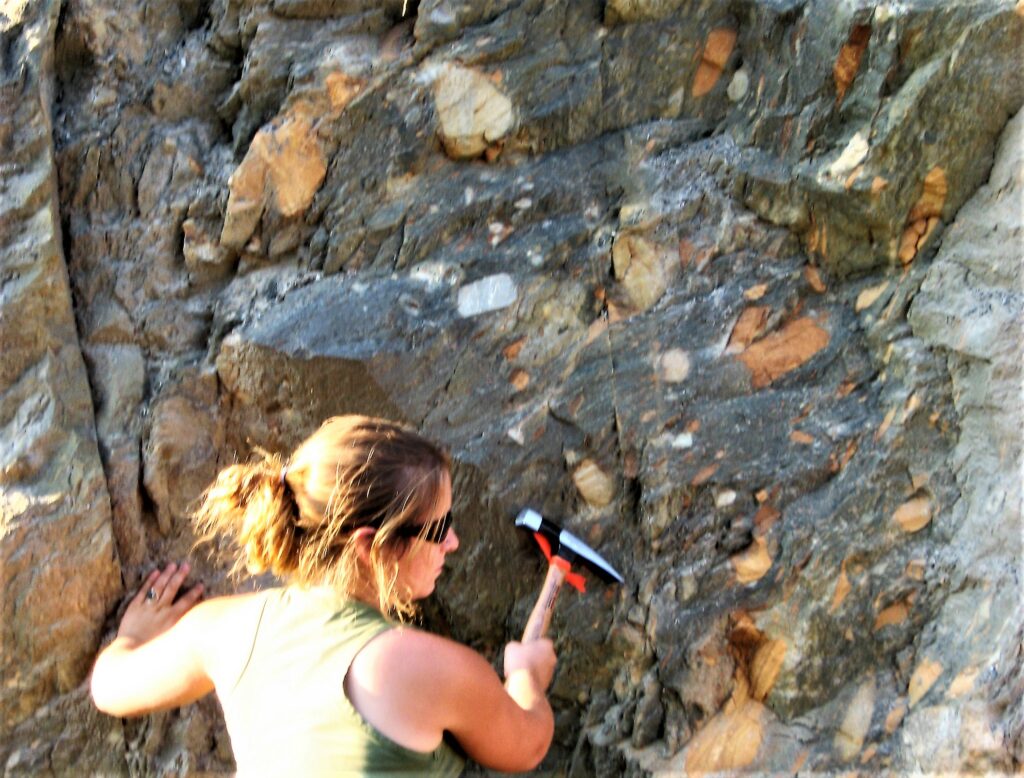3: Climate Changes in Earth’s Past
- Page ID
- 25484
\( \newcommand{\vecs}[1]{\overset { \scriptstyle \rightharpoonup} {\mathbf{#1}} } \)
\( \newcommand{\vecd}[1]{\overset{-\!-\!\rightharpoonup}{\vphantom{a}\smash {#1}}} \)
\( \newcommand{\dsum}{\displaystyle\sum\limits} \)
\( \newcommand{\dint}{\displaystyle\int\limits} \)
\( \newcommand{\dlim}{\displaystyle\lim\limits} \)
\( \newcommand{\id}{\mathrm{id}}\) \( \newcommand{\Span}{\mathrm{span}}\)
( \newcommand{\kernel}{\mathrm{null}\,}\) \( \newcommand{\range}{\mathrm{range}\,}\)
\( \newcommand{\RealPart}{\mathrm{Re}}\) \( \newcommand{\ImaginaryPart}{\mathrm{Im}}\)
\( \newcommand{\Argument}{\mathrm{Arg}}\) \( \newcommand{\norm}[1]{\| #1 \|}\)
\( \newcommand{\inner}[2]{\langle #1, #2 \rangle}\)
\( \newcommand{\Span}{\mathrm{span}}\)
\( \newcommand{\id}{\mathrm{id}}\)
\( \newcommand{\Span}{\mathrm{span}}\)
\( \newcommand{\kernel}{\mathrm{null}\,}\)
\( \newcommand{\range}{\mathrm{range}\,}\)
\( \newcommand{\RealPart}{\mathrm{Re}}\)
\( \newcommand{\ImaginaryPart}{\mathrm{Im}}\)
\( \newcommand{\Argument}{\mathrm{Arg}}\)
\( \newcommand{\norm}[1]{\| #1 \|}\)
\( \newcommand{\inner}[2]{\langle #1, #2 \rangle}\)
\( \newcommand{\Span}{\mathrm{span}}\) \( \newcommand{\AA}{\unicode[.8,0]{x212B}}\)
\( \newcommand{\vectorA}[1]{\vec{#1}} % arrow\)
\( \newcommand{\vectorAt}[1]{\vec{\text{#1}}} % arrow\)
\( \newcommand{\vectorB}[1]{\overset { \scriptstyle \rightharpoonup} {\mathbf{#1}} } \)
\( \newcommand{\vectorC}[1]{\textbf{#1}} \)
\( \newcommand{\vectorD}[1]{\overrightarrow{#1}} \)
\( \newcommand{\vectorDt}[1]{\overrightarrow{\text{#1}}} \)
\( \newcommand{\vectE}[1]{\overset{-\!-\!\rightharpoonup}{\vphantom{a}\smash{\mathbf {#1}}}} \)
\( \newcommand{\vecs}[1]{\overset { \scriptstyle \rightharpoonup} {\mathbf{#1}} } \)
\(\newcommand{\longvect}{\overrightarrow}\)
\( \newcommand{\vecd}[1]{\overset{-\!-\!\rightharpoonup}{\vphantom{a}\smash {#1}}} \)
\(\newcommand{\avec}{\mathbf a}\) \(\newcommand{\bvec}{\mathbf b}\) \(\newcommand{\cvec}{\mathbf c}\) \(\newcommand{\dvec}{\mathbf d}\) \(\newcommand{\dtil}{\widetilde{\mathbf d}}\) \(\newcommand{\evec}{\mathbf e}\) \(\newcommand{\fvec}{\mathbf f}\) \(\newcommand{\nvec}{\mathbf n}\) \(\newcommand{\pvec}{\mathbf p}\) \(\newcommand{\qvec}{\mathbf q}\) \(\newcommand{\svec}{\mathbf s}\) \(\newcommand{\tvec}{\mathbf t}\) \(\newcommand{\uvec}{\mathbf u}\) \(\newcommand{\vvec}{\mathbf v}\) \(\newcommand{\wvec}{\mathbf w}\) \(\newcommand{\xvec}{\mathbf x}\) \(\newcommand{\yvec}{\mathbf y}\) \(\newcommand{\zvec}{\mathbf z}\) \(\newcommand{\rvec}{\mathbf r}\) \(\newcommand{\mvec}{\mathbf m}\) \(\newcommand{\zerovec}{\mathbf 0}\) \(\newcommand{\onevec}{\mathbf 1}\) \(\newcommand{\real}{\mathbb R}\) \(\newcommand{\twovec}[2]{\left[\begin{array}{r}#1 \\ #2 \end{array}\right]}\) \(\newcommand{\ctwovec}[2]{\left[\begin{array}{c}#1 \\ #2 \end{array}\right]}\) \(\newcommand{\threevec}[3]{\left[\begin{array}{r}#1 \\ #2 \\ #3 \end{array}\right]}\) \(\newcommand{\cthreevec}[3]{\left[\begin{array}{c}#1 \\ #2 \\ #3 \end{array}\right]}\) \(\newcommand{\fourvec}[4]{\left[\begin{array}{r}#1 \\ #2 \\ #3 \\ #4 \end{array}\right]}\) \(\newcommand{\cfourvec}[4]{\left[\begin{array}{c}#1 \\ #2 \\ #3 \\ #4 \end{array}\right]}\) \(\newcommand{\fivevec}[5]{\left[\begin{array}{r}#1 \\ #2 \\ #3 \\ #4 \\ #5 \\ \end{array}\right]}\) \(\newcommand{\cfivevec}[5]{\left[\begin{array}{c}#1 \\ #2 \\ #3 \\ #4 \\ #5 \\ \end{array}\right]}\) \(\newcommand{\mattwo}[4]{\left[\begin{array}{rr}#1 \amp #2 \\ #3 \amp #4 \\ \end{array}\right]}\) \(\newcommand{\laspan}[1]{\text{Span}\{#1\}}\) \(\newcommand{\bcal}{\cal B}\) \(\newcommand{\ccal}{\cal C}\) \(\newcommand{\scal}{\cal S}\) \(\newcommand{\wcal}{\cal W}\) \(\newcommand{\ecal}{\cal E}\) \(\newcommand{\coords}[2]{\left\{#1\right\}_{#2}}\) \(\newcommand{\gray}[1]{\color{gray}{#1}}\) \(\newcommand{\lgray}[1]{\color{lightgray}{#1}}\) \(\newcommand{\rank}{\operatorname{rank}}\) \(\newcommand{\row}{\text{Row}}\) \(\newcommand{\col}{\text{Col}}\) \(\renewcommand{\row}{\text{Row}}\) \(\newcommand{\nul}{\text{Nul}}\) \(\newcommand{\var}{\text{Var}}\) \(\newcommand{\corr}{\text{corr}}\) \(\newcommand{\len}[1]{\left|#1\right|}\) \(\newcommand{\bbar}{\overline{\bvec}}\) \(\newcommand{\bhat}{\widehat{\bvec}}\) \(\newcommand{\bperp}{\bvec^\perp}\) \(\newcommand{\xhat}{\widehat{\xvec}}\) \(\newcommand{\vhat}{\widehat{\vvec}}\) \(\newcommand{\uhat}{\widehat{\uvec}}\) \(\newcommand{\what}{\widehat{\wvec}}\) \(\newcommand{\Sighat}{\widehat{\Sigma}}\) \(\newcommand{\lt}{<}\) \(\newcommand{\gt}{>}\) \(\newcommand{\amp}{&}\) \(\definecolor{fillinmathshade}{gray}{0.9}\)After having carefully read this chapter and completed the exercises within it and the questions at the end, you should be able to:
- Describe how the output of the sun has changed over geological time and explain why the Earth’s climate has remained generally consistent, in spite of that change,
- Provide some examples of how changes in the positions of continents that result from plate tectonics have resulted in climate changes in the past,
- Explain how formation of mountain ranges can affect the climate over a period of tens of millions of years,
- Summarize the climate effects of volcanic eruptions on both short and long time scales,
- Describe the ways in which the Earth’s orbit and tilt change over time, and explain how those variations affect the Earth’s climate,
- Explain how past changes in ocean currents have changed the Earth’s climate, and
- Describe some of the ways that impacts of large extraterrestrial objects can affect the Earth’s climate, and why we should be on the lookout for such objects.
- 3.1: Changes in Solar Output and in the Earth’s Atmosphere
- This page discusses the formation of the solar system, the increasing brightness of the sun, and its future as a Red Giant. It highlights the evolution of Earth's atmosphere through photosynthesis, maintaining conditions for liquid water, and the Gaia theory's role in planetary self-regulation. Human-induced disturbances in carbon storage lead to climate imbalance, despite natural feedback mechanisms.
- 3.2: Plate Tectonics and Climate Change
- This page examines the impact of plate tectonics on Earth's geological history, climate, and continental arrangements. It highlights how the configuration of continents, influenced by tectonic movements, has affected albedo and solar energy. Key historical events include the formation of the supercontinent Rodinia, which contributed to global cooling.
- 3.3: Volcanism and Climate Change
- This page discusses the impact of volcanic eruptions on climate, emphasizing the 1991 Pinatubo eruption, which led to short-term cooling due to sulphate aerosols. It highlights the potential long-term warming effect of CO2 from eruptions and historical examples like the Deccan and Siberian Traps that caused significant climate changes and extinctions.
- 3.4: Earth’s Orbital Fluctuations and Climate Change
- This page explores the impact of Milanković cycles on Earth's climate, detailing how variations in orbital parameters influence solar energy distribution, leading to glacial formation, particularly at high latitudes. The text chronicles climate changes over 250,000 years, highlighting that despite peaks in insolation, glacial conditions often intensified, with significant cycles of cooling continuing until around 20,000 years ago.
- 3.5: Ocean Currents and Climate Change
- This page discusses the importance of ocean currents in redistributing thermal energy and influencing climate change, highlighting surface currents and deep thermohaline circulation. It addresses the "salinity oscillator" and its role in climate cycles like the Dansgaard-Oeschger cycles, influenced by salinity variations in the northern Atlantic.
- 3.6: Extraterrestrial Impacts and Climate Change
- This page discusses the K-Pg extinction caused by a meteorite impact in Chicxulub, Mexico. The 12 km-wide asteroid triggered tsunamis, wildfires, and a layer of soot that led to environmental devastation, including darkness, cooling, and acidic rain. Survivors endured difficult conditions for years. Studies referenced include the global tsunami effects and atmospheric changes due to soot, with evidence of early Paleogene warming linked to the event.
- 3.7: Chapter 3 Summary and Questions for Review
- This page outlines factors influencing climate change: increased solar output affects Earth's temperature via greenhouse gases; plate tectonics shifts continents and alters ocean currents; volcanism influences climate through sunlight blockage and CO2 release; Milanković cycles affect glacial periods; ocean currents and salinity changes redistribute heat; and rare extraterrestrial impacts can drastically alter climate. Review questions encourage deeper exploration of these themes.
We are in the midst of a period of significant human-caused (anthropogenic) climate change that has no parallel in Earth history. It is not an exaggeration to call this the key issue of our time and an existential threat. Climate-change is an underlying theme in this book for that reason, and its significance will be considered in virtually every chapter. Although anthropogenic climate change is real and serious, the Earth’s climate has changed significantly in the past—through natural processes. Those who wish to understand anthropogenic climate change need to be aware of natural climate-changing mechanisms, how they worked in past, and whether or not they might be affecting our climate now on a human time scale. These natural processes include solar change, evolution and lifestyles of organisms, continental movements, mountain building, volcanism, variations in the Earth’s orbit and collisions with extra-terrestrial objects.
The geological record is what allows us to detect climate changes that have happened in the past. An example of that is the late Proterozoic Toby Formation, in southeastern British Columbia, which is a fine-grained marine rock (mudstone) with numerous large angular clasts of limestone and quartz (Figure \(\PageIndex{1}\). The mud was deposited in the quiet water of a continental slope environment, and the large clasts were dropped from floating ice derived from glaciers on Laurentia (proto North America) during the Snowball Earth period.

Media Attribution
- Figure 3.0.1 Steven Earle, CC BY 4.0


